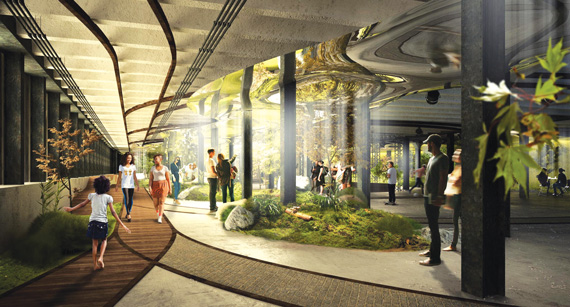Trending
Paradise or pipe dream?
The Lowline looks impressive, but will it evoke Mother Nature or a movie set?

Although there is always considerable risk involved in writing about an architectural project that has not yet broken ground, rarely have the perils been greater than in regard to the subject of this month’s column: an ambitious, and unprecedented subterranean park known as the Lowline. The renderings for this public space and cultural area, which would serve the inhabitants of the Lower East Side, look inspiring — as all renderings do and as all renderings should. The real question, however, is whether the Lowline is an inspired idea or one of the dumbest things anyone has come up with yet.
Near the approach to the Williamsburg Bridge on the Lower East Side and next to the Essex Street subway station on Delancey Street lies a one-acre expanse that was known in better times as the Williamsburg Bridge Trolley Terminal. When trolley cars were abandoned, the place fell dormant — and dormant it has remained for the past 60 years, a time capsule that few of those pounding the pavement above during that time had any idea existed.
The park, a long-simmering pipe dream of co-founders Dan Barasch, a strategist who has previously worked for Google and the City of New York, and James Ramsey, an architect at New York-based Raad Studio, has finally received a nod of approval from the city, which had created an official conduit for its development by putting out a request for proposals earlier this year. Ramsey and Barasch debuted their plans for the park back in 2011, right around the time the nearby Essex Crossing project was wending its way through the city approval process. That project, which was greenlit by the City Council in 2012, is slated to redevelop a hodgepodge of Lower East Side sites into a $1 billion mixed-use development with 500 units of permanently affordable housing, 15,000 square feet of (aboveground) open space, 250,000 square feet of office space, an expanded Essex Street Market and a variety of retail spaces.

Dan Barasch
The Lowline, as the only submission, was the uncontested winner, and if completed, will be the world’s first underground park, running underneath Delancey between Clinton and Norfolk streets.
It is, to be sure, a fascinating idea. Like the High Line, which has been a smashing success with locals and tourists for more than five years now (and from which the Lowline, initially called Delancey Underground, has unself-consciously taken its name), the Lowline would capitalize on the current vogue for decaying infrastructure — one of the most improbable developments in contemporary taste and culture over the past 30 years. This taste, unlike that of earlier generations, does not seek to make the space pristine and spotless, but to preserve as much of the decay as possible. That’s the selling point. The thought that we are underground, that this space was once the Williamsburg Bridge Trolley Terminal and has not seen the light of day since the Eisenhower administration, adds powerfully to the appeal.
But there is, nonetheless, a reason why it will be the first subterranean park in existence — namely, that humans prefer their parks aboveground. Fresh air and light are, after all, the major draws of parks for most city dwellers. Undeterred by that obstacle, however, the designers of the Lowline are confident that by deploying the latest solar technology, they can transform the abandoned Trolley Terminal into a lush zone of year-round fertility, channeling sunlight underground to promote a riot of photosynthesis. If this does indeed become a reality, it will be especially welcome in a part of the city that is significantly lacking in green spaces relative to most other parts of Manhattan.
At the moment, the place is a dingy, dismal netherworld. In photographs of the space, tall rafters with peeling paint and rusting metal are rotting away, and the abjection of the place is accentuated by the pervasive moisture that covers the ground, by the bare lightbulbs, and by the electric cords that loop from them like weird tropical vegetation.
In its futuristic way, the Lowline also aspires to be more than a showcase for green technology — it seeks to repurpose one of New York City’s last developmental frontiers: its subterranean infrastructure. Now that most of Manhattan’s parking lots and gas stations have been converted into luxury condos, its waterfront into parkland and ferry terminals, and its Belle Epoque banks into event spaces and cultural centers, the city’s forgotten underground spaces now beckon to inventive young designers.

James Ramsey
In October of last year, Barasch and Ramsey opened the Lowline Lab, a futuristic space on Essex Street intended to demonstrate the solar technology, designed by Ramsey, they hope will enable subterranean horticulture, and to give visitors a taste of what the Lowline will look and feel like.
Already the space has welcomed more than 70,000 visitors and will remain open on weekends until March 2017. Visitors will find a darkened room of brick and cinder block, with florescent lights propped up by pylons around which extravagant plant life grows, together with tropical fruits and flowers. From the ceiling, long cords of greenery hang down like stalactites in some inner-city cave.
That is in keeping with a preference, in the general design of the project, for bulging, irregular, organic forms that are suggestive of plant life. Renderings by Raad show a complexity of textures and formal ideas. Seating areas of unpolished wood stretch out beside walkways paved by bare concrete. At various points, the sun streams down from the street into the curving, looping spaces. Walls slope inward and are covered in neon green tiles. In contrast to the strict rectilinearity of the walkways, the ceilings are a sequence of organic forms whose metallic gleam recalls puddled mercury.
On the evidence of the Lowline Lab, the planners of the new park are doing an admirable job bringing greenery so improbably underground. But there is something off-puttingly dystopian about the whole thing, which recalls those sci-fi attempts to recreate a post-apocalyptic world on Mars, or underwater, or in the depths of a some desert cave. Will the public wish to go to the Lowline, and once the novelty wears off, will they wish to return?
It’s hard to say how it will all translate in the actual space, particularly as the concept is so cutting-edge that there are no real precedents to help determine whether the result will skew more park than movie set. What is clear, however, is that the concept’s success, as a new variety of park and not just another indoor public space, will depend on whether it can make the unnatural seem natural.




